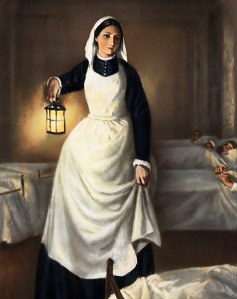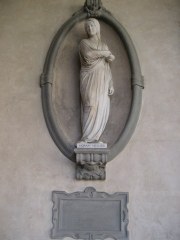 The Basilica of Santa Croce is known for being the burial place of great Italian men such as Michelangelo and Galileo, but as you wander through the cloisters of the church, memorials to other famous non-male and non-Italian figures grab your attention. One name in particular stands out, for why would there be a memorial to an English nurse in an Italian church? As we will see, the answer lies in that woman’s name: Florence Nightingale.
The Basilica of Santa Croce is known for being the burial place of great Italian men such as Michelangelo and Galileo, but as you wander through the cloisters of the church, memorials to other famous non-male and non-Italian figures grab your attention. One name in particular stands out, for why would there be a memorial to an English nurse in an Italian church? As we will see, the answer lies in that woman’s name: Florence Nightingale.
What’s in a name? Florence Nightingale’s is known worldwide as belonging to the founder of modern nursing, but few know that she was actually named after the city in which she was born: Florence, Italy. Nightingale’s parents were wealthy English citizens taking a tour of Europe at the time of her birth and were so enamored with the city that they decided to take a piece of Florence with them by giving the name to their newborn daughter. Even though Florence Nightingale did not spend much of her life in Italy, the English community in Florence commissioned a symbolic memorial in her honor to claim her for their city which can still be found in the first cloister of the Basilica of Santa Croce.
“The time is come when women must do something more than the ‘domestic hearth,’ which means nursing the infants, keeping a pretty house, having a good dinner and an entertaining party.”
As the daughter of a wealthy British family, Florence was expected to secure a good marriage and live the life of a traditional upper class woman as dictated by the patriarchal society in which she lived. However, Florence believed herself to have responsibilities beyond the domestic sphere and applied herself to the field of nursing and medicine. Though they had given her the best education possible, her parents originally discouraged her from pursuing such an inappropriately labor-intensive profession such as nursing, which did not befit the family’s elevated social position. Florence would go on to do amazing things with her life, but it can be said that her first act of greatness was to break free from the confines of 19th century social and gender norms to reject marriage and train as a nurse to serve in the Crimean War. She would never become a wife as was expected of an educated upper class woman, rather she forsake the role of wife to become the world’s leading consultant on civilian and military health care.
“I am of certain belief that the greatest heroes are those who do their duty in the daily grind of domestic affairs whilst the world whirls as a maddening dreidel.”
Florence’s nickname, ‘The Lady with the Lamp’ came from her nightly practice of making the rounds through the hospital to check on the sick and dying with only a lamp to guide her way. She became a symbol of hope in the darkness for these soldiers and ‘the lady with the lamp’ has since become a term to define someone who exemplifies selfless service to others. As a nurse in the Crimean War, Florence experienced the death and destruction of the war firsthand and set out to reform the field of wartime medicine in effect bringing light to the poor hygiene, lack of supplies, and dismal hospital conditions which were actually causing more deaths than war wounds. Florence Nightingale’s methods, detailed in her 1860 book Notes on Nursing: What It Is and What It Is Not, revolutionized the nursing profession and are still used today as the standard for practicing nurses worldwide.
 The epigraph at the base of the memorial translates in English: “Florence Nightingale – The Heroine of Crimea – The Lady with the Lamp, as the soldiers called her, having in her such a wonderful nurse, in the painful hospital nights, and since then a guiding spirit with the virtue of the example to that voluntary work of international pity, that became the Red Cross, has in her Florence, where she was born and of which carried the kind name, this memory and of affection.”
The epigraph at the base of the memorial translates in English: “Florence Nightingale – The Heroine of Crimea – The Lady with the Lamp, as the soldiers called her, having in her such a wonderful nurse, in the painful hospital nights, and since then a guiding spirit with the virtue of the example to that voluntary work of international pity, that became the Red Cross, has in her Florence, where she was born and of which carried the kind name, this memory and of affection.”
Florence Nightingale’s memorial was created by Francis William Sargent in 1913, the epigraph composed by Italian politician and writer, Isidoro Del Lungo, and is but one of the many incredible women who have been honored with memorials in the historic Basilica di Santa Croce. Florence Nightingale may have been English by blood, but she will continue to be venerated as having the heart and spirit of a true Florentine by the people of the city.
Blogger Arielle Sison is a Stanford University student currently studying abroad in Florence. She is pursuing a major in European History with a double minor in Education and Classics and is passionate about Italy’s rich history and culture.
Photo copyright unknown.

Thanks for this great insight! As an Operating Room nurse for the past 37 years, I hoped to see this when we visited Santa Croce in Oct. 2013. For some reason we missed it. All the more reason to return to this fabulous city!
Lesley- Poulsbo, WA
Thank you Leslie, you are right – one more reason to return to Florence! The monument to Florence Nightingale was made just one year after she died, to honor her by the city whose name she had. It is located in the cloister, very close to the exit of our monumental complex. Thanks for reading!
Who is the artist?
Francis William Sargant, an English born sculptor who spent most of his career in Italy and had a studio in Florence. His monument to Nightingale, executed in 1913, is still in its original location in the cloister of Santa Croce.